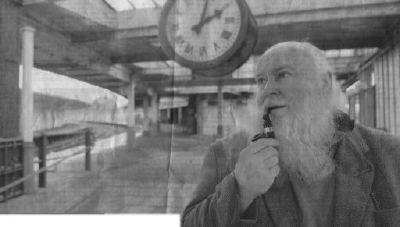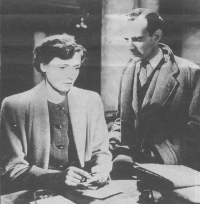All change at the
station of romance |

Bill Seddon, a veteran member of the rail
trust,
stands beneath the clock at boarded up Carnforth Station. |
They were hopelessly in love. But he was a
decent chap,and she was a married lady. Their chaste and doomed affair had moviegoers in
floods of tears.
PETER RHODES reports on the enduring appeal of Brief Encounter and the news that the
station where forbidden passion blossomed is to be saved. |

Celia Johnson and Trevor Howard
in the station buffet. |
THESE days they'd be under the sheets before you could say Carnforth.
But in 1945, nice girls didn't. Not that they didn't know how. During the war years, nice
girls bad been laying down everything for England with an assortment of doomed young
airmen and slick-talking Yanks. But 1945, the year of victory, was also the year when
people tried to re-establish the middle- class values that had been eroded by war.
Enter Celia Johnson and Leslie Howard. They were cast together in Brief Encounter for what
looked like a rather dull yarn of forbidden love.
She was the bored but dutiful housewife, speaking with an upper-crust accent that could
carve holes in carboys. He was the dedicated doctor, ramrod-straight and oozing
respectability. Eventually, chaste but traumatised, they did the decent thing and parted.
For ever.
On paper it looks unpromising. In the hands of director David Lean, it became an
irresistible tearjerker.
Lean wanted to stress the ordinariness of the encounter. So where better to stage it than
on a damp English railway platform? How better to introduce the couple than by Celia
Johnson getting a piece of ash in her eye and Howard gently removing it?
If the nation fell in love with Howard and Johnson, they also fell for the station where
it all began. In the film it was the fictional Milford Junction. The location used for the
movie was Carnforth Station between Preston and Lancashire.
For years, movie fans trooped to Carnforth on a pilgrimage to find the exact spot where
love flourished. Here was the platform, here the clock, here the waiting room where the
refined accents of housewife and doctor contrasted with the working-class banter of
Stanley Holloway and the lady serving the rock cakes.
Today, Carnforth is a shadow of its former glory when magnificent steam expresses hurtled
through on their way to the Lake District, Manchester and Barrow-in-Furness. By 1970 the
platforms had been demolished, leaving Carnforth as a sorry-looking branch-line station.
The only travellers are commuters. The station buffet where so much passion was generated
is boarded up. The place is a bitter disappointment to the trickle of tourists, many from
d the United States and Japan, who drop by every year.
But now the old place, once scheduled for for demolition, is due for a massive makeover.
Over the past few years the Carnforth Station & Railway Trust has raised almost £1
million to recreate Carnforth's glory.
Their plan is to re-open the refreshment room, renovate the buildings and bring back a
steam train.
THEY have just given the go-ahead for the the work, thanks to a £150,000 grant from
Railtrack. The rail company has its own plan for a £400,000 upgrade of that part of the
station used by commuters. "It seemed to make sense to work together with the trust
and do it as one project," says Railtrack spokesman Keith Lumley. "We're giving
them £100,000 with no strings attached and a further £50,000 towards access for the
disabled. It's not a lot but it goes some way towards meeting their needs."
The project will start this summer with a completion date in spring 2001. It is the light
at the end of a dark and frustrating tunnel for trust chairman Peter Yates, a Carnforth
garage owner.
"We've been banging our heads against a brick wall for years to get this far,"
he says. "Honestly, from the reaction from the powers-that-be, you'd think we were
trying to build a nuclear power station here.
"And we've still got to persuade Richard Branson to stop his Virgin trains at
Carnforth. He must have the bottle to see the potential."
All being well, Yates sees the first rock cake being served in Carnforth's refreshment
room in the summer of 2001.
"But this isn't just a restoration," he stresses. "We really want to create
the atmosphere of the time. We need to bring in the expertise of the movie industry."
He has no doubt that the reborn Carnforth will pull in the fans. But why? What is the
enduring appeal of Brief Encounter?
At Railtrack, Keith Lumley admits he's stumped: "I was born after it was made. It's
not really my sort of film."
But for 52-year-old Peter Yates, the film speaks for a generation.
"I remember a golden age, when I was about eight or nine, when this station was a
bustling, lively, jolly, vibrant place," he says. "It was as busy as a motorway
service area. It was nice, it smelt wonderful and there were parcels and happy people
everywhere.
"I have seen Brief Encounter dozens of times. At first you think it's just a naff old
English film. And then you realise how cleverly it was made.
"It's all about the niceness of the old England, the gentility of life that is now
missing. In Japan it is a cult film. They use it in schools to teach children how to show
restraint and how to deal with relationships."
As he talks, you realise that, while the volunteers behind the project may be creating a
practical, money-spinning project, complete with shops, community centre and IT building,
they are also weaving dreams. The hopes and fears of post-war England are stamped in the
stones of Carnforth.
"This is not just an old railway station," says Peter Yates. "This is about
people."
"All change at the station of
romance",© Express and Star, Friday 4 th February 2000
[ Media ]
[ Home ]
|

